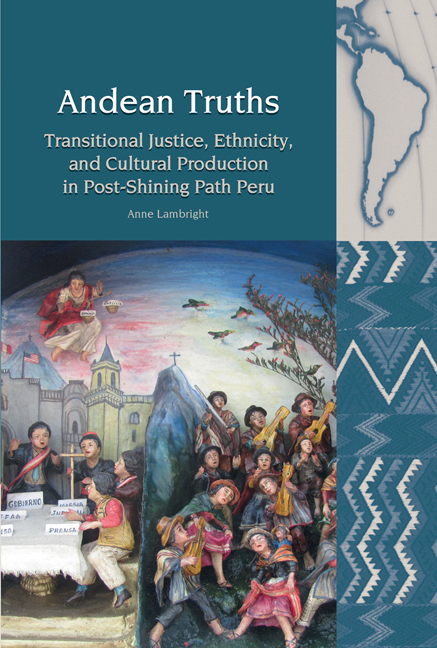Book contents
- Frontmatter
- Contents
- List of Figures
- Acknowledgements
- Introduction
- 1 Sustaining Dominant Narratives
- 2 Transitional Justice and Reconciliation through Identification
- 3 Dead Body Politics
- 4 Towards a Narrative Pachacutic
- 5 Collaborative Truth-Telling
- 6 Reconciling through other Knowledges
- 7 Conclusion
- Works Cited
- Index
3 - Dead Body Politics
- Frontmatter
- Contents
- List of Figures
- Acknowledgements
- Introduction
- 1 Sustaining Dominant Narratives
- 2 Transitional Justice and Reconciliation through Identification
- 3 Dead Body Politics
- 4 Towards a Narrative Pachacutic
- 5 Collaborative Truth-Telling
- 6 Reconciling through other Knowledges
- 7 Conclusion
- Works Cited
- Index
Summary
Grupo Cultural Yuyachkani at the CVR Hearings
The activities, hearings, and Final Report of the CVR generated many cultural responses, which cite in some way the effects of terrorist violence on the human body—as it is tortured, torn apart, forced to migrate, or killed. Works such as the 17,000+ photos of the era archived by the CVR, and partially displayed in the Yuyanapaq exhibit, evoke a disembodied dead, through images of the disappeared, assumed deceased, of whom there remains no corporeal evidence. From the body-part ‘doll’ in Roncagliolo's Abril rojo, to the deceased mother in La teta asustada, to the spirits in Oscar Colchado Lucío's novel Rosa Cuchillo (to be discussed in Chapter 4), time and again, writers and artists find ways to represent the dead and to make present those who were unable to testify before the CVR. Upon examining this collection of cultural artifacts one wonders, to what extent is the new allegory of the Peruvian national subject a mutilated, dismembered, displaced, or dead body?
Regarding the socio-cultural role of the dead and their spirits, sociologist Gordon Avery asserts that ‘to study social life one must confront the ghostly aspects of it;’ this statement rings particularly true in a social setting marked by acute, prolonged national violence. Commenting on the proliferation of dead bodies in Chilean art during and after the Pinochet dictatorship, Nelly Richard observes:
The subject of human rights abuses has sharply marked all Chilean narrative about the national body with images of remains: of bodies that have not been found, bodies that have not been laid to rest. This lack of burial is the image—without recovery—of a historical mourning process, one that never completely assimilates the sense of loss, but rather conserves it in an unfinished, transitional version.
- Type
- Chapter
- Information
- Andean TruthsTransitional Justice, Ethnicity, and Cultural Production in Post-Shining Path Peru, pp. 88 - 106Publisher: Liverpool University PressPrint publication year: 2015



